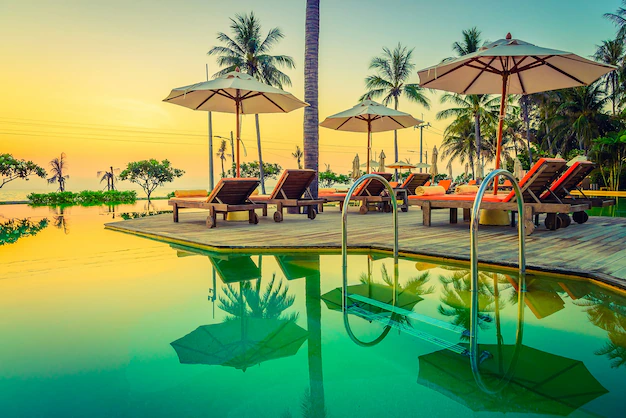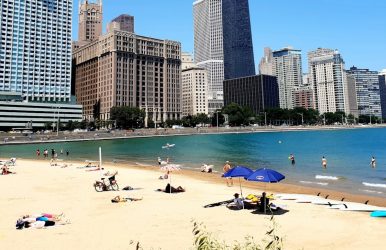THIS Is The Closest Beach To Ohio: A Day Of Peace And Quiet
BY
Sibashree
Sep 20, 2023
A beach vacation is something we all dream about. The sun, sand, and surf provide the getaway you need for both families and beachgoers alike. The sea will provide you with all the scenic views you can ever desire.
But you might be looking for beaches nearest to your location, and if your location is Ohio, then we have a list for you to visit. If you live in Ohio, it is indeed tough to plan a beach day.
Among the options for the closest beach to Ohio, you have are Ocean City, Myrtle Beach, South Carolina, and a few other locations. Let’s enjoy the whiff of the sea and explore the most happening places.
THIS Is The Closest Beach To Ohio | Ocean Beaches Close To Ohio
What is the closest ocean beach to Ohio? It is Atlantic City. However, all the Ohio beaches have something for everyone, from sandy shores to family-friendly activities.
They will help you make memories while not having to travel too many miles. We are sharing with you some of the beaches close to Ohio and how they feel like a daydream!
1. Wrightsville Beach, North Carolina
Located just out of Wilmington, North Carolina, it is one of the most gorgeous beaches close to Columbus Ohio. It is in the vicinity of a college town, and its beach is a popular spot for surfing, with several surf outlets to check out. For families, the Airlie Gardens are more suitable. Justin Waller
It offers breathtaking scenery, whereas the Battleship North Carolina has a historic tour enjoyed by families with kids.
Leisure calls for good food, and these beaches have plenty of restaurants to try out. There are beachfront accommodations available for a more relaxed holiday with a view of the sea while being the closest beach to Ohio.
Distance from Cleveland: 700 miles; approximately 10 hours, 16 minutes
Distance from Columbus: 609 miles; approximately 9 hours, 10 minutes
You can do several watersport activities, including paddleboarding, surfing, kayaking, and SCUBA diving at this closest beach to Ohio! You can go out to experience scenic harbor cruises, sailing the Intracoastal waterway, chartering a boat, deep-sea fishing, or a private excursion.
You can enjoy a beautiful sunset at Johnnie Mercer’s Fishing Pier, where you can birdwatch or go for a jog! The beach experience is quite significant, especially when you are mesmerized by it.
2. Atlantic City, New Jersey
One of the closest ocean beaches to Ohio is Atlantic City, New Jersey. You can reach here from Ohio in under 8 hours. If you are looking for a big-city experience at ocean beaches within 8 hours of Ohio, Atlantic City is your best bet.
There are casino resorts that overlook the coastline with 5-star restaurants and high-street fashion boutiques. One of the best beaches closest to Ohio, this place is suitable for all kinds of beach-goers.
Surfing and kayaking are some of the activities that you can do when you visit the beach. You can make plans during the summer as this beach is perfect for fishing and windsurfing!
If you want adventure as well as entertainment, then all while you are on the beach, AC is the closest ocean beach to Ohio. Events, activities, and entertainment are all an integral part of this closest beach to Ohio.
If you want to choose hotels on the Beach and Broadwalk, then you can go to the Hard Rock Hotel & Casino Atlantic City or the Ocean Casino Resort.
Distance from Cleveland: 493 miles; approximately 7 hours, 20 minutes
Distance from Columbus: 531 miles; approximately 8 hours, 1 minute
There is a huge boardwalk across Atlantic City beach where you can take your children to enjoy! There are different food options, such as fudge, saltwater taffy, and other food items.
There are bars, hotels, and casinos illuminating the sidewalk and boardwalk of Atlantic City Beach. There are mostly seagulls in and around the beach, as there are birds that keep flying around the beach.
3. Maumee Bay State Park Beach (Oregon)
This park beach is another pretty seascape, and the closest ocean beach to Ohio. This park has no entrance fee and, therefore, is quite a popular choice for families. Maumee Bay Beach is the ideal place to spend a sunny day with family and friends. Located in Oregon, it is pretty close (a short drive) to Ohio.
The sand is clean and maintained in the premises of this park. The water, too, is warm and clear, which makes it suitable for swimming or playing while waves hit. Family activities such as picnicking, fishing, and hiking are available for beach-goers, making it one of the most popular beaches around Ohio.
Distance from Cleveland: 110 miles; approximately 1 hour, 58 minutes
Distance from Columbus: 150 miles; approximately 2 hours, 45 minutes
If you are wondering about ocean beaches near Ohio, Maumee Bay State Park should be your utmost choice. There is a Maumee Bay Lodge and Conference Center, too, if you are planning to stay over for the night.
The closest beach to Columbus Ohio, Maumee Bay State Park Beach, has a beautiful campground with fireplaces and an indoor pool and lobby. It is a grassy field which is spacious along with foliage covering the space. You can also go biking when you visit this campsite.
This closest ocean beach to Columbus Ohio is used as a campground close to the lodge and water. There are lodges where helpful staff along with friendly attitude towards the visitors. You can easily enjoy all the activities and services near the beach.
4. Headlands Beach State Park (Mentor)
A beach as pretty as Headlands Beach State Park is hard to find. This is one of the best beach in Ohio. It is located on a long stretch of sandy beach on the coast of Lake Erie. It is an ideal place for swimming, building sandcastles, and sunbathing. This beach also allows pets, but they must be put on a leash.
There are quite a few picnic tables and grills available that allow lakeside lunch and dinner. Being right next to the Headlands Dunes State Nature Preserve, you can get a little more adventurous and take a hike on the trails through the dunes nearby.
Distance from Cleveland: 36 miles; approximately 41 minutes
Distance from Columbus: 170 miles; approximately 2 hours, 33 minutes
This park has the largest natural beach in Ohio. It is a mile-long beach with natural sand. The beach near Columbus is also popular for swimming, beach glass hunting, and sunbathing. At just a 41-minute distance, it is also the closest ocean beach to Cleveland, Ohio.
5. Lakeview Park Beach (Loraine)
Another beach near Ohio for a family is Lakeview Park Beach. The beach is located on Lake Erie. It offers lots of fun family activities. It has a large playground, picnic tables, and lots of open spaces for families and their kids to play and relax in.
The sand here is clean, and the water is equally refreshing. It is one of the most perfect places to soak up the sun and just unwind and thus it is one of the best beaches to live in Ohio. Lake Erie is the 4th largest Great Lake and became famous ever since the War of 1812. It is also one of the warmest of the Great Lakes, which makes it ideal for swimming.
In winter, however, the lake freezes completely. The water flows through the Detroit River, which comes from the upper lakes. The upper lakes include Lake Superior, Lake Huron, and Lake Michigan.
6. Edgewater Beach (Cleveland)
The Edgewater Beach in Cleveland is yet another popular choice for beach lovers in Ohio. It is one of the best family beach towns, and it has loads of beach activities to keep every member entertained. The sand is clean, and the water is clear, making it suitable for sunbathing, swimming, and taking in all the incredible views.
This beach is known for its picture-perfect sunsets. Off-beach entertainment, such as picnic areas, playgrounds, and a fishing pier, are also present for everyone’s enjoyment. For food and dining, there are many restaurants as well as food vendors all over. For a casual meal, try the burgers and pizza joints in the area to get the local taste.
To try something more beachy, there are many seafood and steakhouses around the area. This place is accessible from the lower and the upper sides of Edgewater Park. So, are you still looking for the “closest ocean beach to Cleveland Ohio?” Edgewater Beach is your destination.
7. Alum Creek State Park Beach (Delaware)
Alum Creek State Park Beach in Delaware is one of the best options for free family entertainment that can be counted as one of the closest beaches to Ohio. This park is 4630 acres in size with a wide, sandy beach, which is perfect for sunbathing and having a good time. The water here is shallow and clear, which makes it ideal for swimming or wading. There are also hunting opportunities at this park.
Picnic tables and grills are strewn all over to enjoy a waterside meal. There are quite a few bird-watching as well as hiking opportunities at this park. The Falls trail can be good if you are looking for a challenge. This trail takes you to the top of the falls, where a stunning view greets you, featuring the Delaware River.
There is also a 14-mile mountain biking trail. Beach volleyball courts also allow you to play a hand under the sun. Restaurants and bars nearby complete the deal.
Read More: The Perfect Getaway: Discovering The Closest Beach To Disney World!
8. Ocean City, Maryland
Several activities for kids, such as mini-golf, go-karts, and much more along the Broadwalk, make it a must for beach vacations near Ohio. Moreover, it is the ideal option for all those looking for a beach town that has a little bit of everything.
Ocean City is a large beach town with a similar vibe to the Atlantic City. There are casino resorts on the Broadwalk with many shopping as well as dining options. The beach is 10 miles long, which means there is not much overcrowding.
Some of the best hotels in Ocean City are Hyatt Place Ocean City Oceanfront, DoubleTree by Hilton Ocean City Oceanfront, and Courtyard by Marriott Ocean City Oceanfront.
Distance from Cleveland: 505 miles; approximately 7 hours, 52 minutes
Distance from Columbus: 532 miles; approximately 8 hours, 28 minutes
9. Myrtle Beach, South Carolina
Myrtle Beach is the closest beach to Dayton, Ohio. However, you will have to drive for 9.75 hours to get there.
The weather in Myrtle Beach is subtropical. Furthermore, it has 86 golf courses and 1800 restaurants.
As a result, this beach attracts millions of visitors every year. Further, Myrtle Beach is a popular destination for youngsters.
It has a nickname called “Dirty Beach” due to its history of rowdy partying.
10. South Carolina
Are you still confused about “what are the closest ocean beaches to Ohio?” Let’s try South Carolina.
You already know about Myrtle Beach. However, you will also find beaches such as Hilton Head, Folly Beach, and Hunting Island here.
So, the beaches in South Carolina welcome you with golf courses, lighthouses, historical attractions, luxurious accommodations, and more.
Ocean beaches within 8 hours of ohio
Lake Michigan (Indiana Dunes National Park, Indiana) – ~4-5 hours
Lake Erie (Presque Isle State Park, Pennsylvania) – ~2-3 hours
Cedar Point Beach (Cedar Point Amusement Park, Ohio) – ~2-3 hours
Mackinac Island (Michigan) – ~7-8 hours
Geneva-on-the-Lake (Ohio) – ~1-2 hours
Traverse City (Michigan, Lake Michigan) – ~7-8 hours
These destinations offer a variety of beach experiences, from Great Lakes beaches to Michigan’s scenic coastlines. We will be talking about some of the best beaches that can give you a little joy among all the dreary city days.
Let’s Head To The Best Beaches Close To Ohio
When on a quest for the best beach in Ohio, you might consider the names above. Going on a vacation to the closest beaches to Ohio will create a beautiful experience for you, especially with the wide range of activities.
Starting with hiking to adventures of surfing and swimming, Ohio creates a perfect atmosphere for your entertainment. If you are visiting Ohio with your family, you can also enjoy having a picnic at the beach along with grilling and barbequing.
You can also take a bike for rentals to travel across the beach and enjoy your heart out. There are party racks where you can keep your bike after you plan to go out clubbing or partying, so you do not need to worry about transportation.
If you have questions to ask or thoughts to share, leave a comment below. We would love to hear from you.
The Closest Beach To Ohio: Frequently Asked Questions (FAQs)
Here are some frequently asked questions and answers about the closest beach to Ohio.
What Is The Closest Ocean To Ohio? The Atlantic Ocean is the closest Ocean to Ohio. The Jersey Shore of New Jersey has Ocean City and Wildwood. What Is The Closest Ocean Beach Near Me If I Live In Cincinnati? The closest ocean beach to Cincinnati is East Fork Lake. It is just a 35-minute drive from downtown Cincinnati. However, my silent favorite regarding the closest beach to Cincinnati is Caesar Creek Lake.The 1300-foot public beach in Caesar Creek State Park allows you to camp, hike, and play! What more can you ask for? However, if you are looking for beaches within 10 hours of Cincinnati, you can opt for the Atlantic City. Despite not being the closest ocean beach to Cincinnati by car, it is a must visit for the vibrant events and activities. What Are The Ocean Beaches Within 8 Hours Of Ohio Near Me? Virginia Beach in Virginia and Myrtle Beach in South Carolina are some of the ocean beaches within 8 hours of Ohio, near me. Huntington Beach in Cleveland and Vermilion in Ohio are other ocean beaches within 8 hours of Ohio. What Is The Closest Coastal Beach To Ohio? Kelleys Island State Park Beach is the closest coastal beach to Ohio. The distance between these two places is 101 miles.













